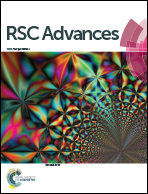Polypyrrole/cellulose nanofiber aerogel as a supercapacitor electrode material†
Abstract
Polypyrrole (PPy)/cellulose nanofiber (CNF) aerogels are prepared using the citric acid-Fe3+ (CIT-Fe3+) colloid as a precursor of the Fe3+ oxidant, which can effectively control the microscopic morphology of the PPy/CNF aerogel due to in situ controlled release of Fe3+ oxidant to initiate polymerization of the pyrrole monomer with the common stimulus being pH. The Brunauer–Emmett–Teller (BET) specific surface area of the PPy/CNFs (25%) aerogel is up to 402 m2 g−1. All solid-state film supercapacitors are fabricated using the PPy/CNF aerogel film as the electrode material. The maximum specific electrode capacitance is about 215 F g−1. The devices also exhibit excellent cycle stability.


 Please wait while we load your content...
Please wait while we load your content...